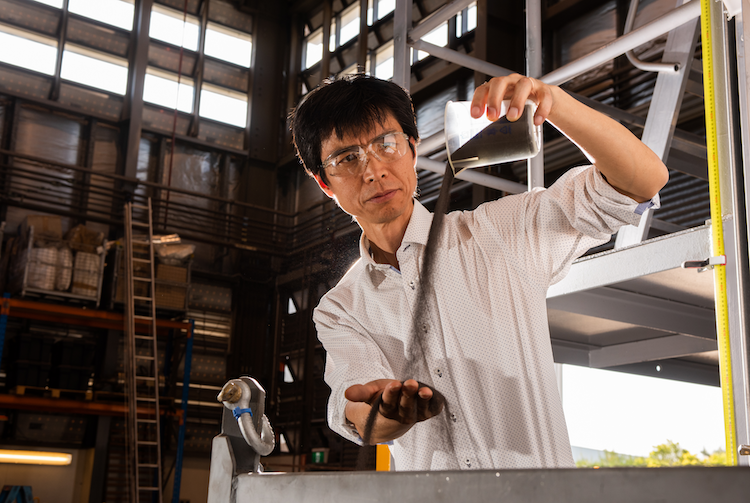Falling Particle Receiver research has been global. Dr Jin-Soo Kim in Australia’s Falling Particles Process Bay, Newcastle Energy Centre IMAGE©CSIRO
Government-funded research into decarbonizing heavy industry using concentrated solar thermal (CST) yields results with the world’s first spin-off based on a new kind of high temperature solar receiver – the falling particle receiver.
Because of the simplicity and durability of particle-based CST, and its ability to operate at very high temperatures, international solar researchers have long believed that it could get to commercial readiness faster than other novel CST technologies under development…
Now it has.
FPR Energy – for Falling Particle Receiver Energy – is the world’s first startup based on this new kind of solar technology, that has been years in the making through international research.
Falling particle receivers are at the cutting edge of CST technologies in which heat is generated by thousands of mirrors that concentrate sunlight into a solar receiver atop a tower. To date, molten salt, a watery liquid, has been used to absorb and transfer the heat in this receiver to be stored to run a traditional steam cycle or deployed as direct heat.
But instead, in falling particle receivers, ceramic particles are used to absorb and transfer this highly concentrated solar heat. The particles fall as a thin curtain over a descending cascade forming the absorber surface of the solar receiver, transferring solar heat to a gas; like air, steam or s-CO2, to store and run a Brayton power cycle, or deployed as – much hotter – direct heat.
Particles enable a high temperature solar breakthrough
“Particle CST technology has no temperature limitation,”confirmed Jin-Soo Kim, who has led solar receiver research at CSIRO for six years as Principal Research Scientist.
“So this is not like the molten salt, which is limited by both high and low temperatures. We can see industrial decarbonization by providing the process heat, and also, depending on the process temperature, it can provide the heat for the thermal chemical reaction. So the application area is quite wide open, depending on the customer’s needs.”
The ceramic particles FPR Energy will use are already used in the gas fracking industry to prop rock fractures apart to liberate natural gas. They are spherical, so they flow like a liquid and have been shown to withstand being heated up to 1200°C and back to air temperature daily for years, making them a robust and durable way to absorb and transfer solar heat.
Tall silos can store the hot particles for firm, fully dispatchable power generation, or to provide consistent 24/7 heat for industrial processes or for producing liquid fuels using solar thermochemistry (see How solar fuels are made).
Record large investment in the first commercial falling particle receiver-based CST
FPR Energy’s three founding partners are the Australian science research institute CSIRO, which holds the IP; industry partner Osaka Gas, who have a long list of customers needing to decarbonize their businesses; and financial venture capital firm RFC Ambrian, which together have invested AUD 15 million, the most that any CSIRO spin-off has ever received.
“RFC Ambrian identified that no one else in the world is deploying particle technologies into a startup company yet. So we’re the first. And their view is the first movers usually have greater success,” said Wil Gardner, former Team Leader of the Solar Thermal Engineering team at the CSIRO solar research unit who is now COO at FPR Energy. The new firm is now looking for its first pre-commercial pilot project.
“But the first customer can’t take all the risks, for example, in a first commercial demonstration at scale, which might be, for example, 30 megawatts, depending on their needs. The first pilot doesn’t necessarily have to be profitable for us. It just has to work. And then the next one we build will be quicker, easier, and cheaper.”
The start-up holds five patents on this technology: for the ways that the falling particles capture heat and store the heat efficiently and for two associated heat exchangers, one in the receiver and one that transfers the heat to hot air or steam when it is to be used onsite.
The heated particles are stored in a tall silo, holding thermal energy for as long as necessary. When needed, the stored heat is transferred via the hot particles to
output heat exchangers.
Falling particle receiver technology has been developed collaboratively over years of international research, in many cases by government-funded scientists. These researchers advanced particle-based solar heat transfer at Sandia National Laboratories in the US, DLR in Germany, and CSIRO in Australia.
Scientists on two continents came up with the initial concept
“Through some discussion around 2016, 2017 I myself and Cliff Ho at Sandia, we found that what we are thinking is quite similar, so we decided to go for a joint patent for one of the basic concepts of the particle receiver design,” Kim noted.
“But since then, each research group working on particle receivers has conducted its own independent research and development with no actual sharing of IP. International collaboration is always a part of government projects, but it is more like linking existing or upcoming independent research projects and sharing information.”
CSIRO moved fastest to advance the falling particle receiver
The US Department of Energy selected particle-based solar technology early on for research as the future of concentrated solar thermal energy. In 2018, Sandia National Laboratories was awarded the DOE Gen-3 funding to advance it and is currently building their fully-integrated two-megawatt demonstration system on their construction site in the US.
But CSIRO in Australia had already been demonstrating a smaller one-megawatt system at its research centre in Newcastle.
“Because we’re collaborating partners with Sandia, they became aware that we had potential funding from ARENA in Australia where we can take that concept and continue working with it,” said Gardner, who had previous startup experience at Ausra, before joining CSIRO.
“With ARENA funding through ASTRI (Australian Solar Thermal Research Institute), CSIRO has further developed that IP with additional features to improve that flow and heat retention capability. Our two patents back in 2020 and 2021 were directly just with CSIRO for the two heat exchangers (input solar receiver, and output heat extraction).”
“The primary heat exchanger is the solar receiver, where you have direct contact heat exchange from solar radiation into the particle media. It was based on developing a particle flow in a cascade to limit the velocity and give the particles resident time to absorb the energy. The second heat exchanger, which extracts heat from storage, has features that no one else has done in this particular arrangement.”
Gardner explained the thinking behind their design to control the falling particle curtain thickness.
“If this is too thin, it becomes transparent, and solar radiation then passes through, and you’re losing – wasting energy. And if the particle curtain gets too thick, then you’re sending cold particles into storage, which you don’t want to do either. So you’ve got to maintain a specific thickness. So when the particle velocity starts to get too fast as it free falls, you stop it, catch it on a horizontal shelf, and re-release it. Then it falls again like a cascade-type water fall, where the water falls into a pool, flows over into the next pool, and keeps going down.”
When scaled up, the aperture of this solar receiver opening would be both wider and taller. So, at a 50 MW scale, for example, the receiver would have a 7-meter-wide surface area, making the cascade of particles wider. However, although the opening would also be taller, the vertical spacing between the catch and release troughs would remain the same; so there would just be a greater number of the vertical troughs slowing the descent of the particles.
Mining Tech shows How Particle CSP can Hoist Tons of Hot Sand
The post Solar research into falling particle receivers results in first spin-off – FPR Energy appeared first on SolarPACES.




